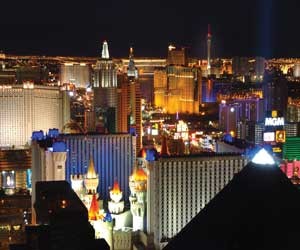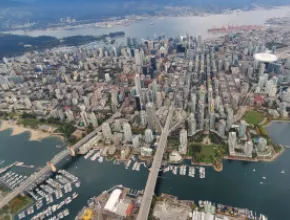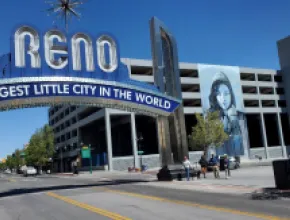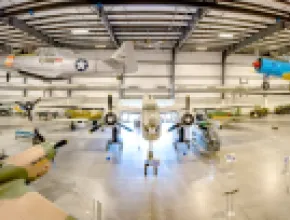In the past, planners who brought a meeting to Las Vegas could be forgiven for thinking that they were, well, a bit small for the town.
After all, mammoth events like the Consumer Electronics Show constantly came and went. Everyone loved Las Vegas, and visitation just kept increasing.
Eighty percent of the city’s business came from weekend leisure travelers, while 20 percent was weekday business travelers who used the same facilities at different times, close to a perfectly efficient business model.
A sky’s-the-limit mentality led properties to build tens of thousands more guest rooms and millions of square feet of meeting space—and people just kept coming and filling them up! Occupancy rates stayed above 90 percent, a great number for any city but a phenomenal one in a town with this many beds.
In this atmosphere, Las Vegas may have been slightly, shall we say, laissez-faire about attracting smaller meetings—with "smaller" meaning fewer than 10,000 room nights.
And then about mid-2008, the exquisitely sensitive antennae of the city’s hospitality-industry officials started twitching: The economy was headed for a downturn, and it would be bad.
By the time the real financial calamities started in early fall, the Las Vegas Convention and Visitors Authority (LVCVA) was executing a plan to deal with the downturn, and it could be summarized as such: We’ve got to take meetings business more seriously than we ever have.
Asked about this, Chris Meyer, vice president of sales at the LVCVA and himself a CEM/CMP, says that while everyone else was getting ready for the 2008 holidays, the LVCVA sent its salespeople into the field with a vengeance.
"We had just begun our first of a series of sales blitzes," Meyer says, referring to December 2008. "From October to the end of January we executed over 1,000 face-to-face sales calls in 372 cities. We asked five questions: How’s your business doing short term, in the next 90 days and then in the next six months? Third, what kind of meeting are you looking at? Corporate? Association? Fourth, what are the destinations you’re considering? And finally, how can we bring you to Vegas?"
Meyer says the strategy gave the destination a real-time look at what was happening in the market.
"Since then we’ve done another round of 1,000 sales calls," he adds.
Since the economy first stumbled, Meyer says, his sales staff has executed almost 3,800 face-to-face calls.
"Not only are we shouting the message, we’re also living it now," he says.
Which should be a welcome departure for meeting planners who might have felt a bit of benign neglect in the past.
"We’re putting forth the concept that if you bring your meeting here, you’re going to get more people than anywhere else," Meyer says.
The LVCVA is also being proactive in reaching out to meeting planners, according to Meyer, who cites the city’s revived Vegas Means Business website (www.vegasmeansbusiness.com).
"We started repurposing that to talk about the value of face-to-face [business] travel," he says. "And we were there before anyone thought about that. Now you see other destinations doing that—Orlando Means Business, Chicago Means Business and so on. I think we galvanized our business."
Asked whether the recession was causing Las Vegas to go through one of its periodic evolutions—for example, to family-friendly perhaps a decade ago and then back to its roots as an adult playground—Meyer doesn’t seem to think such a wholesale change of focus will be necessary.
"Our occupancy is tracking 26 to 30 points higher than everybody else. Average occupancy across the U.S. is 56 percent, but I suspect we’ll close the year at 84 percent," he says, noting that Smith Travel Research traditionally ignores Las Vegas occupancy numbers since they skew the national occupancy picture.
Meyers says Las Vegas has really established itself as the leading indicator for the travel industry—meetings, trade shows, leisure business and travel business in general.
"As Las Vegas goes, the rest of us will follow," he says. "2010 is starting to shape up. There is a significant amount of new business signing up now. It started around May and June and has been escalating since then."
He advises planners looking for deals to visit the LVCVA site at www.visitlasvegas.com for package deals.
"You get a good room rate, two-for-one on a spa, two-for-one on a buffet and a resort credit—and there’s no other place on the planet that has the capability to do that," Meyer says. "I think everybody in group business, in business-to-business travel right now, is in a buyer’s market," with some planners locking deals in for as far out as 2011.
"What I have to point out, too, is we’re the only destination opening anything of significance in the next year. Everyone else is in retrenchment mode," Meyer says.
Indeed, Las Vegas keeps bringing new properties on-line.
Among the biggest developments, MGM Mirage unveiled its massive CityCenter project in December (see the "On Location," side bar), which encompasses several high-end hotels, comprehensive meeting space and a wealth of retail and entertainment options.
Meanwhile, the Hard Rock Hotel staked a major claim to the meetings market with the opening earlier this year of 70,000 square feet of meeting space, which Chris Meyer calls a meetings success story at this previously leisure-focused property. In November the Hard Rock also opened its HRH Tower, with 359 luxury suites and eight spa villas, plus its own spa and nightclub.
The Encore Wynn is now open with 60,000 square feet of meeting space supplementing the 200,000 available at the adjacent Wynn Las Vegas, while two major meetings-friendly developments are set to open in the third quarter of this year: the Cosmopolitan Resort Casino and Echelon Place.
Henderson/Lake Las Vegas
Henderson is a southern suburb of 175,000 that has grown into a resort destination thanks to Lake Las Vegas, an artificial lake that has become the site of several resorts such as Loews Lake Las Vegas and The Ritz-Carlton, Lake Las Vegas (see sidebar).
Henderson has also gained a reputation for wealth and famous residents, from Tony Curtis to Flavor Flav, and routinely attracts top touring acts (especially since the opening of the M Resort Hotel Casino, which in its first year has hosted Crosby, Stills & Nash, Journey and Tim McGraw.
In 2006, Henderson was ranked by Money magazine as one of the top 100 places to live in the U.S. And for meetings? Ed Kirby, national sales manager of the Henderson CVB, says Henderson has lately pursued more association and sports events to combat the recession.
"It’s obviously tough times; the gaming properties are lowering their rates, where non-gaming properties can’t," he says. "We’re going after more sporting events, such as a Jet Ski race on the lake, and we actually beat out Spain to win the right to host a world triathlon championship in 2011."
Kirby notes that the city is negotiating with a private golf course, South Shore, so visiting groups can use it, and is also pursuing basketball, synchronized swimming and even Hacky Sack events.
Summerlin
Summerlin is a master-planned community at the foot of the Spring Mountains, a few miles west of downtown Las Vegas and in close proximity to the Red Rock Canyon National Conservation Area.
Summerlin’s interlinked communities are connected by plentiful bike lanes and small parks that offer outdoor amenities, and there are several meetings-capable properties here, including the JW Marriott Las Vegas Resort and Spa, Red Rock Casino and Element Las Vegas Summerlin.
Laughlin, Mesquite and Primm
Laughlin has always been Las Vegas’ smaller, more relaxed, family-friendly cousin. It occupies a beautiful location along the lower Colorado River, and water taxis connect several of its downtown hotels, eliminating the need for visitors to take cabs, drive or walk downtown.
Meg McDaniel, senior manager, regional sales/extended destinations at the Laughlin Visitors Bureau, says small meetings keep flowing to Laughlin despite any recession-generated bumps.
"Overall, the small-meetings business is still good," she says. "What we’re seeing is groups still meeting, but not in the same numbers. In anything from associations to family groups, everyone wants to get together but not everyone can make the commitment to meeting."
McDaniel notes that the Laughlin Visitors Bureau has maintained its advertising budget and also recently conducted a promotion in conjunction with AARP and its travel partner, Expedia.
"From the meetings side, we’re looking at what some other destinations are doing," she says. "Everyone seems to be out there promoting the package opportunities, and that seems attractive to meetings customers. This is in some ways similar to what we experienced after September 11, where rates dropped across the spectrum. We are known for low room rates, but now we’re in competition with first-tier destinations."
The Flamingo has reopened as the Aquarius Casino Resort Hotel after remodeling all its areas to a water theme, spending $20 million just on its guest rooms. Similarly, the Colorado Belle has done a makeover of the rooms on its boat and two hotel towers, modified its restaurant offerings, and renovated several public areas on the property.
Laughlin also continues to make good use of its riverside location. In March 2010 the city will host the second Wings and Wildlife Festival, in which birdwatchers and other wildlife enthusiasts will descend on Laughlin and attempt to spot some of the more than 300 species of birds that migrate through here each year. The inaugural 2009 festival attracted 300 attendees for lectures, a wine-and-cheese reception, moonlight kayaking and other field trips.
"It’s taking off, no pun intended," McDaniel says, adding that trails projects slated for Laughlin and its immediate surroundings should further boost the city’s appeal among amateur ornithologists.
McDaniel also promotes the cities of Primm and Mesquite, which lie on Nevada’s borders with California and Arizona, respectively.
"You’ve got three unique destinations that offer the same amenities you find in bigger cities, but with more affordable pricing, and you feel like you’re in a small town," she says. "You’re the big fish."
Nestled in the Virgin River Valley, Mesquite is well known for its seven world-class golf courses and proximity to Zion and Bryce National Parks, plus the presence of several non-gambling properties such as the Embassy Suites and the Falcon Ridge Hotel. Several other properties, such as the Virgin River Hotel, CasaBlanca Resort and Peppermill Resort Hotel & Casino, do offer casino games.
Primm is just 30 minutes south of Las Vegas and, for the casual visitor, is known primarily for the designer outlet mall connected to the Primm Valley Resort, which features brands such as Coach and Williams-Sonoma.
The resort includes two other properties, Buffalo Bill’s and Whiskey Pete’s, which altogether have about 21,000 square feet of meeting space and a separate indoor arena that seats 6,000. The three are connected by monorail and shuttle, and all three attract SMERF and association meetings along with some corporate retreats.
"If you’re looking for a more relaxed atmosphere," McDaniel says, "Mesquite, Laughlin and Primm can provide that experience, including more outdoor activities right at your fingertips."
—Freelancer Paul D. Kretkowski is relieved that what happens in Vegas, stays in Vegas.






